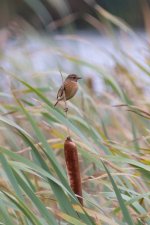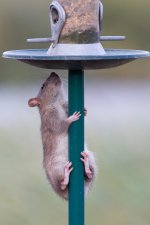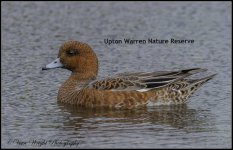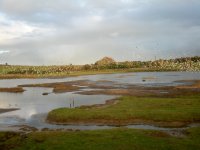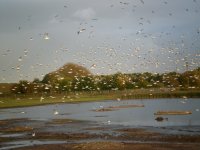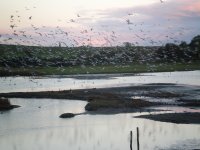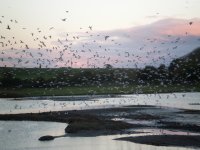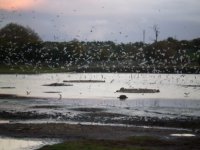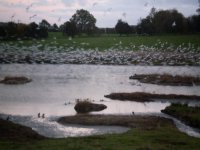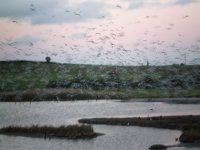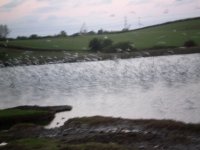-
Welcome to BirdForum, the internet's largest birding community with thousands of members from all over the world. The forums are dedicated to wild birds, birding, binoculars and equipment and all that goes with it.
Please register for an account to take part in the discussions in the forum, post your pictures in the gallery and more.
You are using an out of date browser. It may not display this or other websites correctly.
You should upgrade or use an alternative browser.
You should upgrade or use an alternative browser.
Upton Warren (22 Viewers)
- Thread starter andythomas
- Start date
More options
Who Replied?Phil Andrews
It's only Rock and Roller but I like it

JTB reports an outstanding roost at the Flashes tonight -3500 BH Gulls and 1400 large gulls including a Yellow-legged and presumed adult BALTIC GULL (seen earlier this evening at Grimley). Hopefully there will be some photos later of its time at Grimley; a possible adult Baltic Gull was also reported from last night's roost at Bartley Res.
Photos by Brian from its time at Grimley late afternoon: http://www.worcesterbirding.co.uk/worcestershire_bird_news_60.html. Some thoughts on Baltic Gull identification to compare: http://www.surfbirds.com/mb/Features/gulls/baltic-heuglins-gulls.html
See you are online Steve N - any thoughts?
Last edited:
Brian Stretch
Well-known member
Just added some notes and pictures of the presumed Baltic Gull on the Grimley thread here.
Brian
________________
Worcester Birding
Follow Worcester Birding on Twitter @WorcsBirding
Brian
________________
Worcester Birding
Follow Worcester Birding on Twitter @WorcsBirding
upstarts1979
Well-known member
Phil has already mentioned the roost, more later.
Arrived at 7am (1st light), Rob G was already at the gate. The gull roost and the rest of the roosting birds were still settled, possibly kept down by the strong SSW wind. but by 7.45AM most of the roost had left. I then attempted a 'VIS MIG' session, but the wind was too strong and in the wrong direction.
But somehow a few meadow pipits, skylarks and redwing got through the adverse conditions heading south. The male stonechat performed well at the back of the 1st Flash. But generally things were quiet, other than the usuall finches feeding on the saltmarsh and ducks dabbling in the shallows. I opened the new sluice to gauge how much water we can drop off in a set period. By the end of the day, the periphery had a broad belt of mud. I would like to think any passing waders would be dropping in tomorrow. With the roost building up, I decided to stay and complete the whole dawn till dusk shift.
Pied wags were gathering in good numbers in front of the hide on the newly exposed mud , as were the snipe in the southern end. A small flock of starling circled and later roosted in the 3rd Flash reeds, where surprisingly the pied wags followed. But my attention swiftly turned to the massed ranks of gulls. The BHG's were streaming in, well it was more of a torrent really. A 1st winter common gull was the highlight, but then from nowhere, large gulls were falling out of the sky. The Flashes were soon overwhelmed, the 1st and 2nd Flash were full of gulls and the central area too was cheek to cheek. After receiving a text from Brian Stretch, that a 'baltic; type gull had just left Grimley with BHG's heading ENE, the emphasis on the BHG's shifted to the big boys. The range of ages of LBBG and herring gulls mixed with different forms of each can be a daunting task, if you are at Bartley. But at upton with only 1500 birds, its a bit easier. Anyway after finding an adult yellow legged, a good in itself, I couldn't believe my eyes:eek!: when a small, white headed, 'black' (upper parts ) gull walked out of the crowd the - BALTIC GULL. What a beauty, most noticeable was the long, completely black primary projection. Other features included:- yellow bill with an orange red spot on lower mandible tip, white unmarked head accentuated by the black upperparts, small eye, bright yellow legs, the white tipped tertials contrasted markedly with the rest of the black wings and upperparts. The white 'mirror' of P10 (10th primary) was seen on the underwing. In flight the underwing appeared mostly dark. All in all a cracking bird.
Species counts FLASHES
Teal 148, shoveler 63, mallard 105, tufted, canadas 240, coot 14, moorhen 45, water rail, snipe 34, lapwing 120, curlew 18, green sand 1 poss 2 tonight, BHG 3000, LBBG 1350, herring gull 150, YELLOW LEGGED GULL Adult, BALTIC GULL adult, common gull 3 (2x 1st winter, 2nd winter), Buzzard 6, sparrowhawk 2, raven 2, stock dove 15, collared dove, skylark 9, redwing 20, song thrush 3, grey wag 3, pied wag 120+ roosted 3rd flash reed bed, meadow pipit 8, stonechat male, cettis warbler, chiffchaff, linnet 10, starling 50, reed bunting 15.
Arrived at 7am (1st light), Rob G was already at the gate. The gull roost and the rest of the roosting birds were still settled, possibly kept down by the strong SSW wind. but by 7.45AM most of the roost had left. I then attempted a 'VIS MIG' session, but the wind was too strong and in the wrong direction.
But somehow a few meadow pipits, skylarks and redwing got through the adverse conditions heading south. The male stonechat performed well at the back of the 1st Flash. But generally things were quiet, other than the usuall finches feeding on the saltmarsh and ducks dabbling in the shallows. I opened the new sluice to gauge how much water we can drop off in a set period. By the end of the day, the periphery had a broad belt of mud. I would like to think any passing waders would be dropping in tomorrow. With the roost building up, I decided to stay and complete the whole dawn till dusk shift.
Pied wags were gathering in good numbers in front of the hide on the newly exposed mud , as were the snipe in the southern end. A small flock of starling circled and later roosted in the 3rd Flash reeds, where surprisingly the pied wags followed. But my attention swiftly turned to the massed ranks of gulls. The BHG's were streaming in, well it was more of a torrent really. A 1st winter common gull was the highlight, but then from nowhere, large gulls were falling out of the sky. The Flashes were soon overwhelmed, the 1st and 2nd Flash were full of gulls and the central area too was cheek to cheek. After receiving a text from Brian Stretch, that a 'baltic; type gull had just left Grimley with BHG's heading ENE, the emphasis on the BHG's shifted to the big boys. The range of ages of LBBG and herring gulls mixed with different forms of each can be a daunting task, if you are at Bartley. But at upton with only 1500 birds, its a bit easier. Anyway after finding an adult yellow legged, a good in itself, I couldn't believe my eyes:eek!: when a small, white headed, 'black' (upper parts ) gull walked out of the crowd the - BALTIC GULL. What a beauty, most noticeable was the long, completely black primary projection. Other features included:- yellow bill with an orange red spot on lower mandible tip, white unmarked head accentuated by the black upperparts, small eye, bright yellow legs, the white tipped tertials contrasted markedly with the rest of the black wings and upperparts. The white 'mirror' of P10 (10th primary) was seen on the underwing. In flight the underwing appeared mostly dark. All in all a cracking bird.
Species counts FLASHES
Teal 148, shoveler 63, mallard 105, tufted, canadas 240, coot 14, moorhen 45, water rail, snipe 34, lapwing 120, curlew 18, green sand 1 poss 2 tonight, BHG 3000, LBBG 1350, herring gull 150, YELLOW LEGGED GULL Adult, BALTIC GULL adult, common gull 3 (2x 1st winter, 2nd winter), Buzzard 6, sparrowhawk 2, raven 2, stock dove 15, collared dove, skylark 9, redwing 20, song thrush 3, grey wag 3, pied wag 120+ roosted 3rd flash reed bed, meadow pipit 8, stonechat male, cettis warbler, chiffchaff, linnet 10, starling 50, reed bunting 15.
Last edited:
Stone Snapper
Warrener till i snuff it
upstarts1979
Well-known member
Flashes Roost
Although sometimes a bit hit and miss, the roost at the Flashes can be quite impressive. Not just for the gulls , but also wildfowl, waders and now pied wags and starlings. Tonight I was overwhelmed by all the birds arriving, if more people were present then who knows what else could have bene found.
If you do go tomorrow, make sure you find out what time the gates close and leave your car parked safely outside, if before 6.45pm. B John
John
Although sometimes a bit hit and miss, the roost at the Flashes can be quite impressive. Not just for the gulls , but also wildfowl, waders and now pied wags and starlings. Tonight I was overwhelmed by all the birds arriving, if more people were present then who knows what else could have bene found.
If you do go tomorrow, make sure you find out what time the gates close and leave your car parked safely outside, if before 6.45pm. B
stoneycurlew
Member
The grey wagtail with an 'orange tinge' that has been around the east hide area...
http://youtu.be/oDY0bGWf4JA
http://youtu.be/oDY0bGWf4JA
Stone Snapper
Warrener till i snuff it
No sign of Baltic gull
Phil Andrews
It's only Rock and Roller but I like it

No sign of Baltic gull
The larger gulls tend to arrive late at the Flashes roost and then leave very early the following morning, often under the cover of darkness.
Last edited:
Stone Snapper
Warrener till i snuff it
The larger gulls tend to arrive late at the Flashes rost and then leave very early the following moning, often under the cover of darkness.
glad it wernt there if its a moning rost bird 8-P
Sy V
Well-known member
glad it wernt there if its a moning rost bird 8-P
Did you get JTB to send this?
Phil Andrews
It's only Rock and Roller but I like it

John's roost count yesterday of 3,500 Black-headed Gulls equalled the reserve set on the 30th July 1996 whilst the count of 1,350 Lesser Black-backed Gulls smashed the previous record of 1,000 birds noted over the reserve on three dates – south over the reserve on the 19th November 1994, south along the valley at the back of the orchard at the Flashes on the morning of 14th January 1996 and over the Moors Pool on the 13th January 2002.
Birder Gladys
Well-known member
JTB you will never guess what I saw this morning, a Sparrowhawk flew inbetween the rear of the flashes hide and bushes then darted through the hawthorn bushes that we cleared of the wild hop last work party.
upstarts1979
Well-known member
JTB you will never guess what I saw this morning, a Sparrowhawk flew inbetween the rear of the flashes hide and bushes then darted through the hawthorn bushes that we cleared of the wild hop last work party.
put the hops back Tim8-P
upstarts1979
Well-known member
carpark Flashess tonight
ccar park at SAILING CENTRE WILL BE OPEN UNTL DARK. GARY PRESCOTT WILL BE LOCKING UP AFTER LAST BIRDET HAS LEFT CHEERS
ccar park at SAILING CENTRE WILL BE OPEN UNTL DARK. GARY PRESCOTT WILL BE LOCKING UP AFTER LAST BIRDET HAS LEFT CHEERS
Phil Andrews
It's only Rock and Roller but I like it

ccar park at SAILING CENTRE WILL BE OPEN UNTL DARK. GARY PRESCOTT WILL BE LOCKING UP AFTER LAST BIRDET HAS LEFT CHEERS
Is a birdet like a bidet but bigger to accommodate your r's?
Stone Snapper
Warrener till i snuff it
Did you get JTB to send this?
No Sy this was Mr Andrews attempt before he corrected it:-O
Birder Gladys
Well-known member
Phil has already mentioned the roost, more later.
Arrived at 7am (1st light), Rob G was already at the gate. The gull roost and the rest of the roosting birds were still settled, possibly kept down by the strong SSW wind. but by 7.45AM most of the roost had left. I then attempted a 'VIS MIG' session, but the wind was too strong and in the wrong direction.
But somehow a few meadow pipits, skylarks and redwing got through the adverse conditions heading south. The male stonechat performed well at the back of the 1st Flash. But generally things were quiet, other than the usuall finches feeding on the saltmarsh and ducks dabbling in the shallows. I opened the new sluice to gauge how much water we can drop off in a set period. By the end of the day, the periphery had a broad belt of mud. I would like to think any passing waders would be dropping in tomorrow. With the roost building up, I decided to stay and complete the whole dawn till dusk shift.
Pied wags were gathering in good numbers in front of the hide on the newly exposed mud , as were the snipe in the southern end. A small flock of starling circled and later roosted in the 3rd Flash reeds, where surprisingly the pied wags followed. But my attention swiftly turned to the massed ranks of gulls. The BHG's were streaming in, well it was more of a torrent really. A 1st winter common gull was the highlight, but then from nowhere, large gulls were falling out of the sky. The Flashes were soon overwhelmed, the 1st and 2nd Flash were full of gulls and the central area too was cheek to cheek. After receiving a text from Brian Stretch, that a 'baltic; type gull had just left Grimley with BHG's heading ENE, the emphasis on the BHG's shifted to the big boys. The range of ages of LBBG and herring gulls mixed with different forms of each can be a daunting task, if you are at Bartley. But at upton with only 1500 birds, its a bit easier. Anyway after finding an adult yellow legged, a good in itself, I couldn't believe my eyes:eek!: when a small, white headed, 'black' (upper parts ) gull walked out of the crowd the - BALTIC GULL. What a beauty, most noticeable was the long, completely black primary projection. Other features included:- yellow bill with an orange red spot on lower mandible tip, white unmarked head accentuated by the black upperparts, small eye, bright yellow legs, the white tipped tertials contrasted markedly with the rest of the black wings and upperparts. The white 'mirror' of P10 (10th primary) was seen on the underwing. In flight the underwing appeared mostly dark. All in all a cracking bird.
Species counts FLASHES
Teal 148, shoveler 63, mallard 105, tufted, canadas 240, coot 14, moorhen 45, water rail, snipe 34, lapwing 120, curlew 18, green sand 1 poss 2 tonight, BHG 3000, LBBG 1350, herring gull 150, YELLOW LEGGED GULL Adult, BALTIC GULL adult, common gull 3 (2x 1st winter, 2nd winter), Buzzard 6, sparrowhawk 2, raven 2, stock dove 15, collared dove, skylark 9, redwing 20, song thrush 3, grey wag 3, pied wag 120+ roosted 3rd flash reed bed, meadow pipit 8, stonechat male, cettis warbler, chiffchaff, linnet 10, starling 50, reed bunting 15.
Thanks for the count John. I will confirm that the roost was very impressive, even moreso as it gradually got lighter. Even more impressive was the way it emptied without a mass exodus. Something worth watching time and again. Once again thanks for everything yesterday.
Birder Gladys
Well-known member
Similar threads
- Replies
- 1
- Views
- 1K
Users who are viewing this thread
Total: 23 (members: 1, guests: 22)




